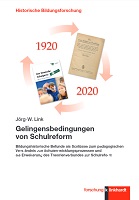Gelingensbedingungen von Schulreform
Bildungshistorische Befunde als Schlüssel zum pädagogischen Verständnis von Schulentwicklungsprozessen und als Erweiterung des Theorienverbundes zur Schulreform
| dc.contributor.author | Link, Jörg-W. | |
| dc.date.accessioned | 2023-03-17T13:55:35Z | |
| dc.date.available | 2023-03-17T13:55:35Z | |
| dc.date.issued | 2023 | |
| dc.identifier.uri | https://library.oapen.org/handle/20.500.12657/61735 | |
| dc.description.abstract | This work presents a structural and operative model of successful processes of school reform, based on eleven source-based studies on the history of educational and school-based pedagogy. Oriented on real-world cases and sources, these studies analyse the reform practices of historical reform schools during the twentieth century. The point of reference in each case is the individual school as a pedagogical unit of action. The studies are historically and empirically grounded and provide in-depth insights into the historical practices of schools as well as historical school reforms. The term “conditions for success” is employed here to focus on organisational structures and pedagogical patterns of action within historical processes of reform. The findings are derived from the inherent logic of practical pedagogical processes of reform. These are structures and patterns of action developed by the pedagogical professionals themselves through social processes. The results of the educational-historical source studies are collated here in a model of recurring professional patterns of pedagogical action and structure. The resulting historically and empirically developed “Five-plus-two-K Structure of Successful School Reform Processes” was tested on 100 modern day reform schools and it could be shown that these processes recur over a period of about one hundred years. Following the inherent logic of pedagogical processes in schools, the “Five-plus-two-K Structure of Successful School Reform Processes” was developed through a process of professional pedagogical action, shaped by professional pedagogical action and interaction, and was differentiated for professional pedagogical action. This model is integrative on the basis that it is primarily pedagogically constituted and was closely developed with educational professionals. The model is thus an educational-historical contribution to a theory of school reform processes and contributes to the pedagogical understanding of the processes of school development. | en_US |
| dc.language | German | en_US |
| dc.relation.ispartofseries | Historische Bildungsforschung | en_US |
| dc.subject.classification | thema EDItEUR::J Society and Social Sciences::JN Education | en_US |
| dc.subject.other | progressive education, school reform, school development, teachers, school research, experimental school, school pedagogy, educational change, history of education, twentieth century, Reformpädagogik, Schulreform, Schulentwicklung, Lehrer, Schulforschung, Versuchsschule, Schulpädagogik, Bildungsreform, Historische Bildungsforschung, 20. Jahrhundert | en_US |
| dc.title | Gelingensbedingungen von Schulreform | en_US |
| dc.title.alternative | Bildungshistorische Befunde als Schlüssel zum pädagogischen Verständnis von Schulentwicklungsprozessen und als Erweiterung des Theorienverbundes zur Schulreform | en_US |
| dc.type | book | |
| oapen.abstract.otherlanguage | Auf der Grundlage von elf bildungshistorischen und schulpädagogischen Quellenstudien wird ein Struktur- und Handlungsmodell gelingender Schulreformprozesse entwickelt. Die Studien analysieren fallorientiert und quellengestützt die Reformpraxen an historischen Reformschulen des 20. Jahrhunderts. Bezugspunkt ist dabei jeweils die Einzelschule als pädagogische Handlungseinheit. Die Studien sind historisch-empirisch fundiert und geben vertiefte Einblicke in historische Schul(reform)praxis. Fokussiert werden mit dem Terminus Gelingensbedingungen organisationale Strukturen und pädagogische Handlungsmuster innerhalb der historischen Reformprozesse. Die Befunde leiten sich aus der Eigenlogik pädagogisch-praktischer Reformprozesse ab. Es sind Strukturen und Handlungsmuster, die von den pädagogischen Akteur*innen im sozialen Prozess selbst entwickelt wurden. Der Ertrag der bildungshistorischen Quellenstudien bündelt sich in einem Modell wiederkehrender pädagogisch-professioneller Handlungs- und Strukturmuster. Diese historisch-empirisch entwickelte „Fünf-plus-zwei-K-Struktur gelingender Schulreformprozesse“ wurde an 100 gegenwärtigen Reformschulen überprüft und konnte im Ergebnis in einem Zeitraum von rund einhundert Jahren als wiederkehrend validiert werden. Entstanden im Prozess professionellen pädagogischen Handelns, gestaltet durch professionelles pädagogisches Handeln und Interaktion und ausdifferenziert für professionelles pädagogisches Handeln folgt das Fünf-plus-zwei-K-Strukturmodell der Eigenlogik pädagogischer Prozesse in der Schule. Es ist anschlussfähig, weil es primär pädagogisch konstituiert ist und sich nah bei den Akteur*innen befindet. Das Modell ist somit ein bildungshistorischer Beitrag zu einer Theorie von Schulreformprozessen und trägt zum pädagogischen Verständnis von Schulentwicklungsprozessen bei. | en_US |
| oapen.identifier.doi | 10.35468/6004 | en_US |
| oapen.relation.isPublishedBy | 9a084ee3-3f86-4be2-81d6-89c9fbc5f173 | en_US |
| oapen.relation.isbn | 9783781525627 | en_US |
| oapen.pages | 281 | en_US |
| oapen.place.publication | Bad Heilbrunn | en_US |
| oapen.remark.public | Funder name: Land Brandenburg/Funder program name: Publikationsfonds für Open-Access-Monografien des Landes Brandenburg |

